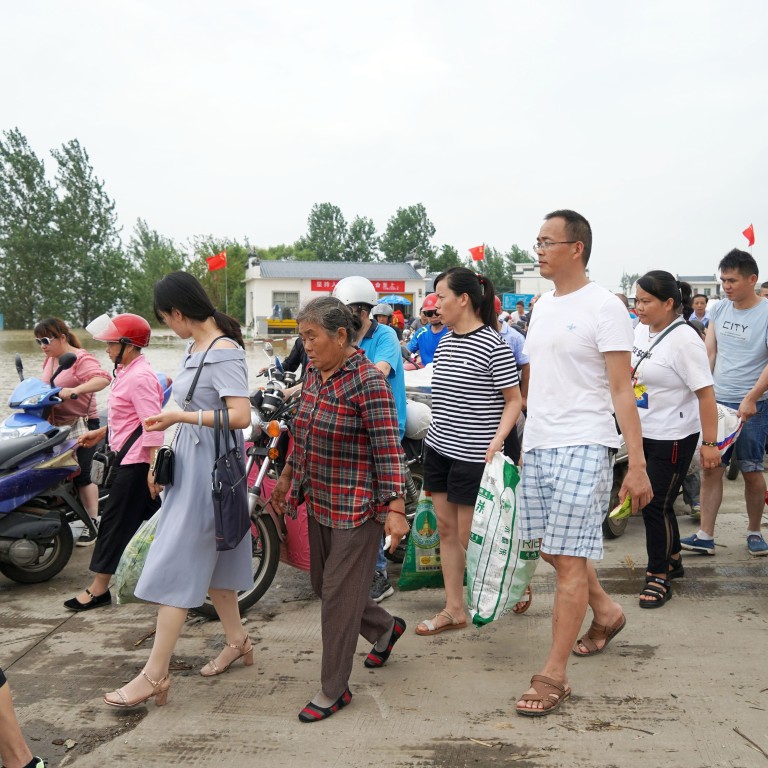
China floods: rural areas plea for migrant workers to return home and fight deluge
- Urbanisation has long been an engine for China’s economic growth, but this has created an apparent problem in the nation’s vast countryside – a hollowing out of rural areas
- On the flood-battered island of Jiangzhou in the middle of the Yangtze River, the population has plunged 80 per cent in less than a decade
When Zhou Yanfu learned that rising floodwaters were threatening his hometown in eastern China’s Jiangxi province, he immediately rushed home to save his 80-year-old mother.
Two days later, he was called back again – this time to save the town itself.
Zhou, 59, lives and works in the nearby city of Jiujiang, across the Yangtze River from Jiangzhou, an island town in the middle of the river that is desperate for help in fighting massive flooding that has spread to 27 mainland provinces, affecting more than 34 million people.
Carrying nothing but a backpack upon his return, Zhou answered the call by Jiangzhou authorities who issued a desperate appeal for all able-bodied men from the island to return and defend their hometown.
“This is my duty,” Zhou said. “I can patrol, and I can help with the preparations [for flood control].”
Zhou is one of the hundreds of millions of rural Chinese residents who left the countryside in recent decades to live and work in cities amid the most rapid and massive urbanisation push in human history.
But although urbanisation has long been an engine for China’s economic growth, it has also created an increasingly apparent problem in the nation’s vast countryside – a hollowing out of small villages and rural towns.
Most young people have left Jiangzhou for opportunities elsewhere, leaving behind only the elderly and children whose parents are not affluent enough to move them to big cities.
In its public appeal letter, the local government said: “There are only about 7,000 people in Jiangzhou, most of whom are elderly and women, with a deployable labour force of fewer than 1,000.” Thus, all men from Jiangzhou aged 18-60 were being called back to protect the dykes and “fight the flooding”.
The letter, which has been widely reported by mainland media, sheds light on China’s shocking demographic change – exacerbated by decades of strict birth-control measures. According to the most recent population data for Jiangzhou, the island had 36,251 residents in 2013. In other words, the island has lost about 80 per cent of its population in less than a decade.
After the public plea, about 3,000 workers returned to man defence lines, the local government said.
Zhou remembers the days when the island was full of young and able hands. That was evident during the town’s last great flood in 1998. He was on the front line then, too. “At that time, maybe one out of 10 [residents] had left Jiangzhou; as of now, nine out of 10 have left,” he said.
And Jiangzhou is not an isolated example. Xinjian, a district in Jiangxi’s provincial capital Nanchang, also sent out a plea for its young men to come back to fight the flood.
China’s demographic changes – featuring a shrinking labour force, declining birth rates, a rapidly ageing society and the swelling concentration of people in a few economic centres – could have a far-reaching impact on the future of the world’s second-biggest economy.
At the end of 2019, China’s urbanisation level had risen to 60.6 per cent, with about 848 million out of 1.4 billion people living in cities, emptying out rural villages.
There’s no way to make a living here [in Jiangzhou]. The young have all moved out to find jobs.
China’s labour force, defined as those between the ages of 16 and 59, has been dwindling for years, fanning speculation that China’s “demographic dividend”, a population structure that favours economic growth, is disappearing.
The toll this takes is particularly heavy on villages and small rural towns such as Jiangzhou, where there are few job prospects.
“There’s no way to make a living here,” said Deng Fuzhou, a 55-year-old local resident. “The young have all moved out to find jobs, mostly in [neighbouring] Jiujiang.”

As the water level rose higher than the dyke that surrounds the island, villagers and soldiers built a 10km (6.2-mile) defence line with plastic sheeting and layer upon layer of sandbags.
As of Tuesday, the flood’s peak on the Yangtze had passed in the Jiujiang region, heading downstream to other eastern provinces, but the water levels in nearby lakes and tributaries remained high, and Jiangzhou was still on high alert.
Gao Xuewu, originally from the town, also took leave from his work in Jiujiang to return and help. He stayed in a makeshift flood station near the dyke for more than 24 hours, checking every half-hour for leakage.
“The floods are serious,” he said. “I’m part of Jiangzhou. I have to stay and contribute.”

.jpg?itok=H5_PTCSf&v=1700020945)